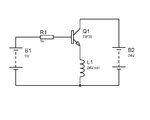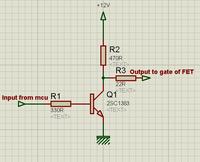assadmahmood
Junior Member level 3
- Joined
- Oct 23, 2011
- Messages
- 30
- Helped
- 0
- Reputation
- 0
- Reaction score
- 0
- Trophy points
- 1,286
- Location
- Karachi Pakistan
- Activity points
- 1,531
Greetings EveryBody!
I am using TIP35C darlington pair transistor IC. The prblem is that I am giving 24VDC, 3Amp on collector and supplying 5VDC, 1Amp on base, there is a solenoid between emitter and ground. Then I got the same voltage on solenoid as base voltage which means that I.C is not conducting from collector to emitter.
I also tried by 12V as base voltage but the result remain the same,
Any suggestion>?
I am using TIP35C darlington pair transistor IC. The prblem is that I am giving 24VDC, 3Amp on collector and supplying 5VDC, 1Amp on base, there is a solenoid between emitter and ground. Then I got the same voltage on solenoid as base voltage which means that I.C is not conducting from collector to emitter.
I also tried by 12V as base voltage but the result remain the same,
Any suggestion>?


